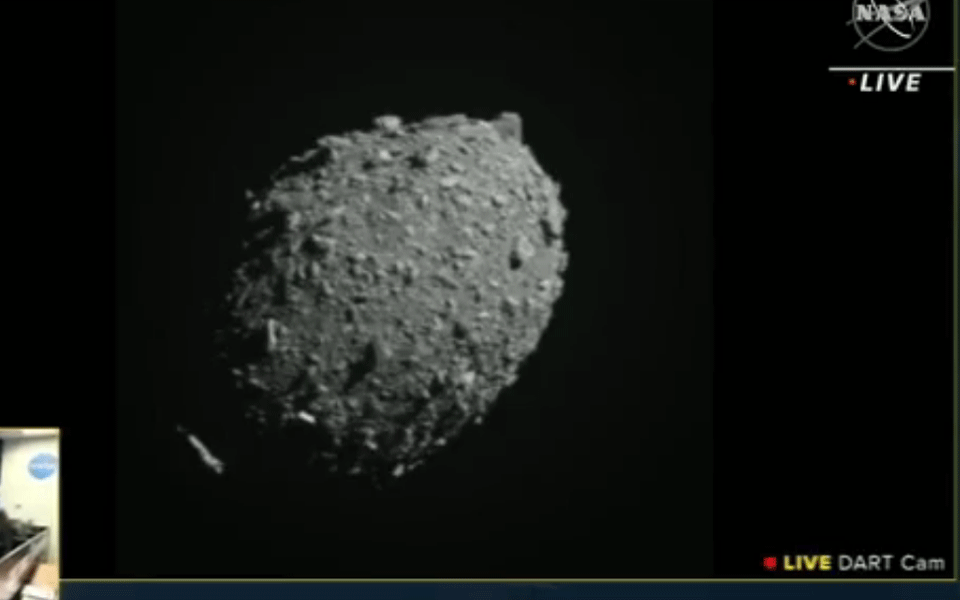Washington(PTI): After flying in space for 10 months, a NASA spacecraft successfully crashed into an asteroid on Tuesday in a first-of-its-kind mission to test whether space rocks that might threaten Earth in the future could be nudged safely out of the way, the US space agency said.
The Double Asteroid Redirection Test (DART) the world's first planetary defence technology demonstration -- targeted the asteroid moonlet Dimorphos, a small body just 160 metres in diameter.
Dimorphos orbits a larger 780-metre asteroid called Didymos. Neither asteroid poses a threat to Earth.
The mission's one-way trip confirmed NASA can successfully navigate a spacecraft to intentionally collide with an asteroid to deflect it, a technique known as kinetic impact, the agency said.
"At its core, DART represents an unprecedented success for planetary defense, but it is also a mission of unity with a real benefit for all humanity," said NASA Administrator Bill Nelson.
"As NASA studies the cosmos and our home planet, we are also working to protect that home, and this international collaboration turned science fiction into science fact, demonstrating one way to protect Earth," Nelson said in a statement.
The team will now observe Dimorphos using ground-based telescopes to confirm that DART's impact altered the asteroid's orbit around Didymos.
Researchers expect the impact to shorten Dimorphos' orbit by about 1 per cent, or roughly 10 minutes. Precisely measuring how much the asteroid was deflected is one of the primary purposes of the full-scale test.
"Planetary Defence is a globally unifying effort that affects everyone living on Earth," said Thomas Zurbuchen, associate administrator for the Science Mission Directorate at NASA.
"Now we know we can aim a spacecraft with the precision needed to impact even a small body in space. Just a small change in its speed is all we need to make a significant difference in the path an asteroid travels," Zurbuchen said.
The spacecraft's sole instrument, the Didymos Reconnaissance and Asteroid Camera for Optical navigation (DRACO), together with a sophisticated guidance, navigation and control system enabled DART to identify and distinguish between the two asteroids, targeting the smaller body.
These systems guided the 570-kilogramme box-shaped spacecraft through the final 90,000 kilometers of space into Dimorphos, intentionally crashing into it at roughly 22,530 kilometers per hour to slightly slow the asteroid's orbital speed.
DRACO's final images, obtained by the spacecraft seconds before impact, revealed the surface of Dimorphos in close-up detail.
Fifteen days before impact, DART's CubeSat companion Light Italian CubeSat for Imaging of Asteroids (LICIACube), provided by the Italian Space Agency, deployed from the spacecraft to capture images of DART's impact and of the asteroid's resulting cloud of ejected matter.
In tandem with the images returned by DRACO, LICIACube's images are intended to provide a view of the collision's effects to help researchers better characterise the effectiveness of kinetic impact in deflecting an asteroid.
"DART's success provides a significant addition to the essential toolbox we must have to protect Earth from a devastating impact by an asteroid," said Lindley Johnson, NASA's Planetary Defense Officer.
"This demonstrates we are no longer powerless to prevent this type of natural disaster.
"Coupled with enhanced capabilities to accelerate finding the remaining hazardous asteroid population by our next Planetary Defense mission, the Near-Earth Object (NEO) Surveyor, a DART successor could provide what we need to save the day," Johnson said.
With the asteroid pair within 11 million kilometers of Earth, a global team is using dozens of telescopes stationed around the world and in space to observe the asteroid system.
Over the coming weeks, they will characterise the ejecta produced and precisely measure Dimorphos' orbital change to determine how effectively DART deflected the asteroid.
The results will help validate and improve scientific computer models critical to predicting the effectiveness of this technique as a reliable method for asteroid deflection.
"This first-of-its-kind mission required incredible preparation and precision, and the team exceeded expectations on all counts," said Ralph Semmel, Director at the Johns Hopkins Applied Physics Laboratory (APL) which controlled the mission.
"Beyond the truly exciting success of the technology demonstration, capabilities based on DART could one day be used to change the course of an asteroid to protect our planet and preserve life on Earth as we know it," Semmel added.
IMPACT SUCCESS! Watch from #DARTMIssion’s DRACO Camera, as the vending machine-sized spacecraft successfully collides with asteroid Dimorphos, which is the size of a football stadium and poses no threat to Earth. pic.twitter.com/7bXipPkjWD
— NASA (@NASA) September 26, 2022
Let the Truth be known. If you read VB and like VB, please be a VB Supporter and Help us deliver the Truth to one and all.
New Delhi (PTI): A Delhi court on Friday extended the NIA custody of deported gangster Anmol Bishnoi by seven more days.
Special Judge Prashant Sharma ordered the extension during a hearing conducted at the National Investigation Agency's (NIA) headquarters here amid high security.
The hearing was not conducted at the designated court in the Patiala House courts as the NIA cited a high security risk to Bishnoi because of threats given by Pakistani gangster Shahzad Bhatti.
Sources said the agency sought the extension of Anmol's custody by seven more days on the ground of conducting further probe, which the judge allowed.
Wanted in connection with the killing of Nationalist Congress Party (NCP) leader Baba Siddique, firing at actor Salman Khan's residence in April 2024, the killing of Punjabi singer Sidhu Moosewala, among other crimes, Anmol was "removed" from the United States on November 18.
He was detained in the US in November last year.
After being produced before a special judge in the Patiala House courts on November 18, he was sent to the NIA's custody for 11 days.
On November 29, Anmol, the brother and a close aide of gangster Lawrence Bishnoi, was sent for further custodial interrogation till December 5.
Absconding since 2022, US-based Anmol is the 19th accused to be arrested for involvement in the terror-gangster syndicate led by his jailed brother.





